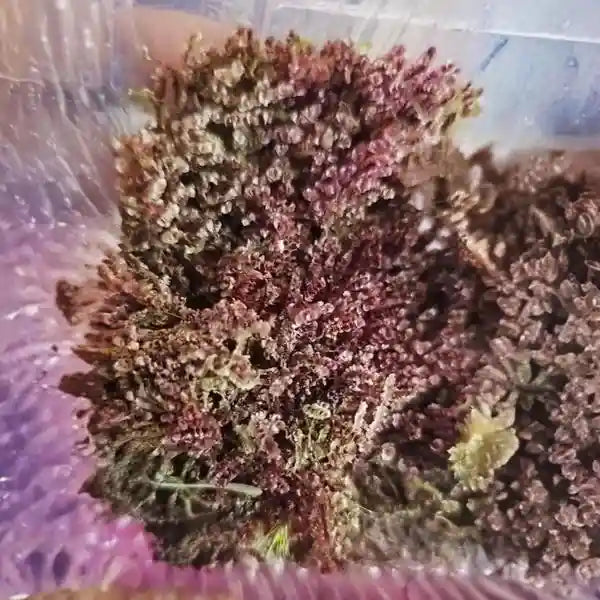
Red Moss for Terrarium - Rare
Selling Size: Same Size | Free Shipping | Secure Packing
Red moss in terrariums can refer to a few different types of plants, but two common ones are Red Sphagnum Moss (Sphagnum sp.) and Ruby Red Club Moss (Selaginella erythropus 'Ruby Red') or Ceratodon purpureus (Purple Moss). While they share a reddish hue, their care requirements can differ slightly. Here's a general guide, with specifics for each type where relevant:
General Terrarium Care for Red Moss:
Mosses thrive in terrarium environments because terrariums help maintain the high humidity they need.
1. Humidity:
Crucial for all mosses. Aim for high humidity, ideally above 70%.
Closed terrariums are best for maintaining consistent humidity.
Mist regularly with distilled, rain, or reverse osmosis water to keep the moss damp but not waterlogged.
Monitor condensation: If you see excessive condensation, your terrarium might be too humid and needs a bit of ventilation. If it's too dry, increase misting or seal the terrarium more tightly.
Airflow: Even with high humidity, mosses need some airflow to prevent fungal growth. Open the terrarium lid and fan it with your hand once or twice a week, especially before misting.
2. Lighting:
Bright, indirect light is generally preferred.
Avoid direct sunlight: This can quickly overheat a closed terrarium and dry out the moss, causing it to brown or lose color.
Artificial lights: If natural light is insufficient (e.g., in a dark room), full-spectrum LED grow lights are a good option. They provide the necessary wavelengths for photosynthesis without excessive heat.
Red Sphagnum Moss: The intensity of its red color often favors brighter, cooler conditions.
Ceratodon purpureus: Prefers shady areas with indirect sunlight.
3. Watering:
Keep consistently moist, but not soggy. Mosses don't have true roots to draw up water from deep within the soil, so they rely on surface moisture.
Use pure water: Tap water often contains minerals and salts that can build up and harm moss over time. Distilled, rainwater, or reverse osmosis water is best.
Misting: The primary method of watering.
Drainage: A drainage layer (e.g., gravel, LECA) at the bottom of your terrarium is essential to prevent waterlogging and root rot (even though mosses don't have roots, it benefits the overall terrarium health). A barrier (like a mesh screen) between the drainage layer and substrate is also recommended.
4. Substrate/Soil:
Mosses don't need deep soil as they don't have extensive root systems. They often grow on surfaces.
Well-draining, moisture-retentive, and slightly acidic are key characteristics.
Recommended mixes:
Peat moss: Excellent for retaining moisture and acidifying the soil.
Coconut coir: Good for aeration and moisture retention.
Perlite: Improves drainage.
Activated charcoal: Can be added for filtration and to prevent odors.
For Red Sphagnum Moss: A loose carnivorous plant soil mix (often peat-based) is beneficial.
For Ceratodon purpureus: Prefers moist, well-drained soil high in organic matter, with a pH between 5 and 6.5.
Some specific "red mosses" like Andreaea alpina (Terrarium Red Moss) naturally grow on rock slate.
You can also use specialized terrarium mixes like ABG mix.
5. Temperature:
Most red mosses used in terrariums prefer warm, stable temperatures. For example, Ruby Red Club Moss thrives between 65-80°F (18-27°C). Avoid cold drafts or drastic temperature fluctuations.
6. Fertilization:
Mosses generally have minimal fertilization needs.
If you choose to fertilize, use a very weak, diluted, balanced liquid fertilizer every 1-2 months during active growth (spring to fall). Over-fertilizing can harm them. Some sources even suggest organic fertilizers like diluted goat milk for mosses.
7. Specifics for Different "Red Mosses":
Red Sphagnum Moss (Sphagnum sp.): This is a true moss often found in peat bogs. It can vary in color from salmon pink to maroon/dark red, especially in brighter, cooler conditions. It tends to form tight, carpet-like mounds. Keep very moist and use pure water (rain/distilled).
Ruby Red Club Moss (Selaginella erythropus 'Ruby Red'): Despite its common name, this is a lycopod (a type of clubmoss), not a true moss. It's known for its striking ruby-red underside and green top. It's a slow grower and prefers partial shade and high humidity. It's a terrestrial plant, so it should not be submerged in water.
Ceratodon purpureus (Purple Moss/Redshank): This true moss has dark green leaves and purple/red stems. It's quite adaptable and doesn't require as much water or sunlight as some other mosses, making it a good terrarium choice. It prefers shady conditions.
Benefits of Red Moss in Terrariums:
Aesthetic Appeal: Adds a vibrant pop of color and unique texture.
Humidity Regulation: Acts like a sponge, absorbing and slowly releasing moisture, which is crucial for the terrarium's microclimate.
Substrate Cover: Helps to prevent soil erosion and keeps the substrate in place.
Natural Habitat: Provides a lush, natural environment for other plants and even small invertebrates (like springtails and isopods, which are beneficial for terrarium health).
Antibacterial Properties: Sphagnum moss, in particular, has acidic properties that can suppress bacterial growth.
By providing the right balance of light, humidity, and substrate, you can enjoy a vibrant and thriving red moss in your terrarium!

